A standard must-see element of the annual International Builders’ Show (IBS), is a report on the latest housing and economic outlook findings by the NAHB’s Chief Economist, Robert Dietz.
Here’s a collection of insights from this report that we found to be of most relevance to homeowners and prospective homebuyers in the coming year, and the impact they may have in the coming years.
Table of Contents
- Construction Costs & Availability of Appliances & Materials
- Labor Shortage for Trade Professionals
- Single Family Building Trends
- IBS 2023 Resource Links
Also see:
- 19 Home Products We Love from Design & Construction Week 2023
- The New American Home 2023: Ultra Serenity, Views & Efficiency
- The New American Home 2022: A Courtyard Design for a Narrow Lot
- More Recommended Reading
- Related Topics: Architecture | Construction | Design | Inspiration | Energy Efficiency | Sustainability
Construction Costs & Availability of Appliances & Materials
Challenging supply chain availability was a recurring theme throughout residential construction over the past year, including The 2023 New American Home project. Supply chain issues should be expected to persist for home projects of all sizes, in the near term.
With prevalent unpredictability, homeowners and homebuyers need to do keep availability in mind when selecting products and materials, as unexpected delays can dramatically increase the complexity of a home project, which will likely increase costs and time to completion. For example, not having the right product in hand for the corresponding contractor, can make re-scheduling highly in-demand workers extremely challenging.
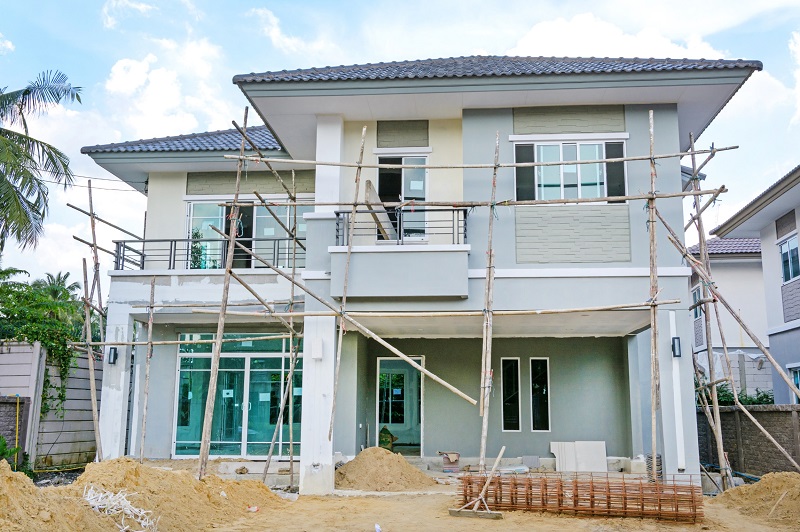
We recommend taking a “bird in hand” approach when encountering supply chain risks. Many products can be easily replaced or upgraded in the future, but putting a project on hold for a novel product or material, with potentially marginal benefits, can be a very risky tactic to take during unpredictable periods. Product availability and strong vendor relationships are critical variables to keep in mind, as well, when hiring contractors for major construction projects.
On the other hand, lumber pricing was a bright spot during 2022, as it declined for residential building, due to slowing demand.
Labor Shortage for Trade Professionals
Shortages in skilled labor persist across the home building and home improvement industry across the country.
During the past few years, a large percentage of highly experienced trade professionals have retired, while a low percentage of young workers have entered the construction industry. Various non-profits, such as Generation T, are focusing on increasing awareness of the career opportunities within the trade professions with high school and junior college students.
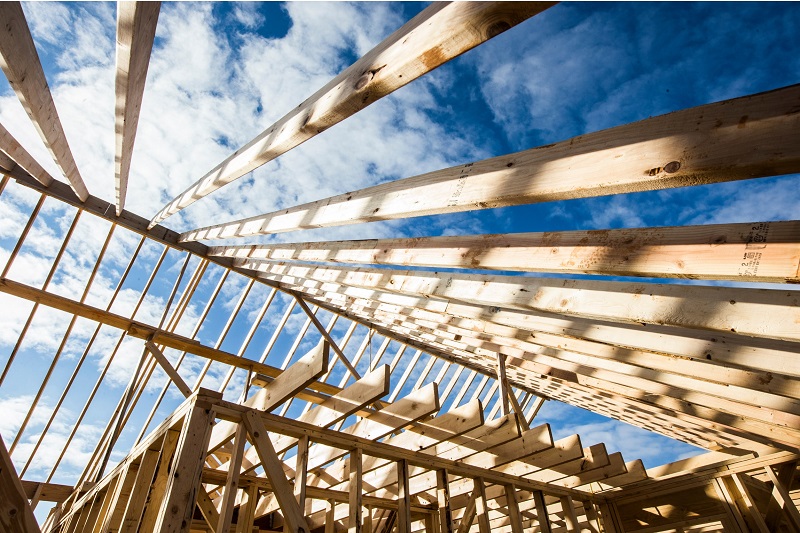
The good news is that the trades represent tremendous career opportunities for young people who are looking for alternatives to college, especially for those with entrepreneurial interests and instincts. The labor shortage will also force business owners and entrepreneurs to innovate, which represents an invaluable learning experience for new workers entering the trades.
Three macro-trends are underscoring these career opportunities:
- A large number of experienced trades professionals retiring each year or permanently leaving the trades, equating to a demand of 740,000 new workers needed each year
- Technology is influencing the construction field at an accelerated rate, enabling builders, contractors and workers to do more at faster rates, at lower costs, and improved reliability
- Innovation within the prefab space will also enable a new breed of home builder which is more of a home integrator, again allowing these innovative builders and entrepreneurs to do more with fewer personnel, at a faster pace
The goal of these non-profits is to:
Recruit, Train and Retain
Though Dietz mentioned that a high percentage of youth prefer to work “in front of computer screens”, this year’s TNAH architect and builder, Michael Gardner, ironically told Purgula that he launched his building firm, LUXUS Design Build, because he had become “tired of spending so much time in front of a computer screen“.
We agree with his revelation that it can be a healthy alternative to pursue a profession that allows you to spend time outside getting regular physical activity, while interacting with others in person.
We also expect to see a new generation of home professionals that will represent the second and third generation of video influencers like Mike Holmes and Matt Risinger. Given the public’s insatiable appetitie to learn about their homes, talented and personable trade workers also have the opportunity to combine two passions: their craft with their love of social media.
Dietz also opined that the cost-benefit-analysis of college will continued to be questioned as part of a national debate. NAHB puts the trade labor shortage at approximately 400,000 workers in the US.
Trade labor earnings shared by the NAHB:
Half of the payroll workers in construction earn more than $50,460 annually and the top 25% make at least $71,000. In comparison, the U.S. median wage is $49,150 while the top 25% make at least $67,410.
Single Family Building Trends
NAHB has a more conservative view on the dearth of homes in the United States with an estimate of 1.5 million too few homes. Freddy Mac, on the other hand, estimates that there is a shortage of 4 million homes!

However, when hearing Dietz mention the small demographic size of the youngest American population cohort, Generation Alpha (ages 0-8 years), one can’t help but believe that a housing surplus can be expected within 25 to 30 years. NAHB expects to start seeing a softening in housing demand as early as 2030, due to weakening demographics of prospective homebuyers.
With the average age of American homes currently at 40 years, the future for remodelers, pre-sale renovation specialists, and house flippers will remain strong. Further fueling demand for remodels and renovations is one third of workers continuing to work from home that will motivate homeowners to get more functionality and usable space out of their home layouts.
Homeowners with mortgages tied to lower rates will also have financial incentive to upgrade their current homes instead of making new purchases at higher rates.
This increasing average age of the American home is reflected in the current percentage of teardown construction projects (i.e. new homes built on existing lots, with the original home completely removed) at 9%, with the previous number at 6%. We suspect that this figure would be significantly higher in affluent real estate markets like Los Angeles, where homeowners with financial means prefer new original designs, in tandem with modern building methods, materials and styles and technologies.
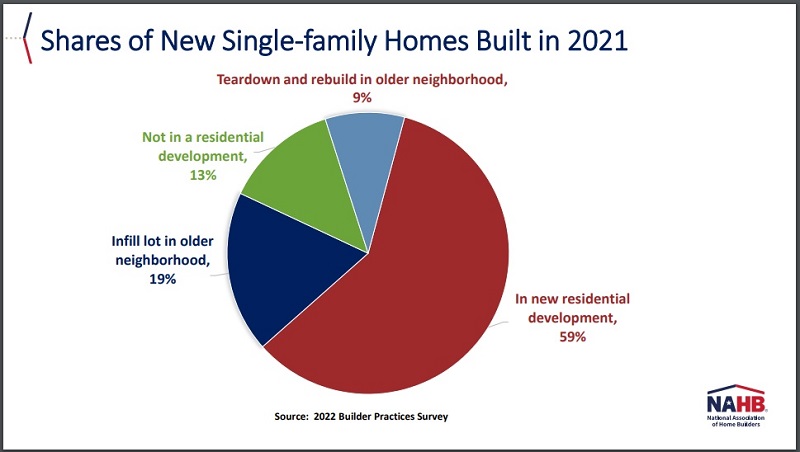
Local communities should be supportive of teardown construction projects as the introduction of better materials and methods will reset longer house lifespans, and increase the aggregate values of a given neighborhood.
Single Family Starts
Single-family home starts, which fell 12% in 2022 (from 999,000 in 2021 to 744,000 in 2022), would drop an additional 26% in 2023 before the downward trend is expected to reverse. New construction for multifamily housing is predicted to have a 28% decline in 2023 (from 545,000 in 2022 to 391,000 in 2023).
“Just 42% of new and existing home sales are currently affordable to a typical household,” a stat highlighted in recent press release announcing NAHB’s latest industry findings.
Most Popular Building Markets
Dietz cited data from the US Census Bureau of the most popular single family construction markets for 2022.
Top 10 Largest Single Family Construction Markets by Unit Building Permits
- Houston-The Woodlands-Sugar Land, Texas
- Dallas-Fort Worth-Arlington, Texas
- Phoenix-Mesa-Scottsdale, Arizona
- Atlanta-Sandy Springs-Roswell, Georgia
- Austin-Round Rock, Texas
- Charlotte-Concord-Gastonia, North Carolina & South Carolina
- Orland-Kissimmee-Sanford, Florida
- Tampa-St. Petersburg-Clearwater, Florida
- Nashville-Davidson-Murfreesboro-Franklin, Tennessee
- Jacksonville, Florida
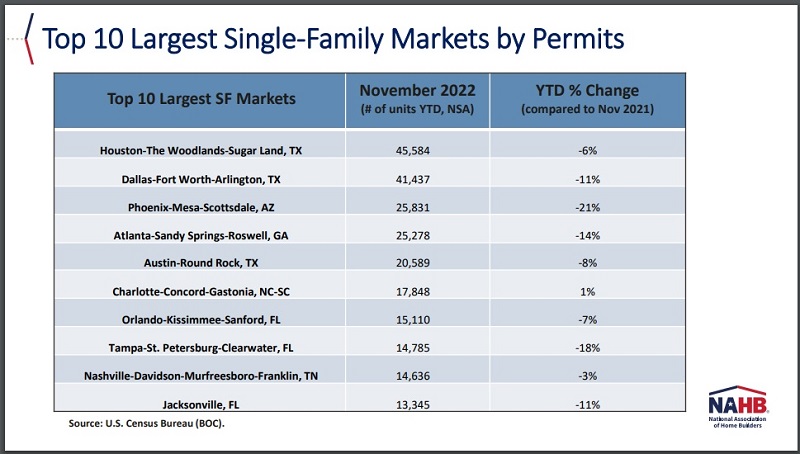
Dietz’s closing slide shared these takeaways for a medium-term outlook for residential construction:
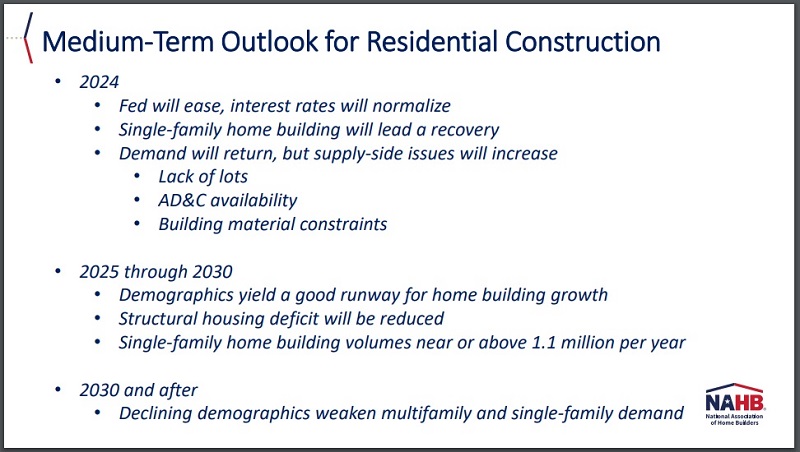
IBS 2023 Resource Links
- About Design & Construction Week
- IBS 2023 Conference Website
- IBS 2023 Directory of Exhibiting Companies
- The New American Home 2023: Website
- The New American Home 2023: Products
- The New American Home 2023: Suppliers
- KBIS Conference Website
Recommended Reading
- The New American Remodel 2021: Sustainable & Energy Efficient Beauty
- The New American Remodel 2022: A Mid-Century “Modernized” Preservation
- Building Technologies for Disaster Resistant Homes
- 10 Exceptional Products in The New American Home 2021
- KBIS 2022: Dometic’s DrawBar: A Sleek Wine Cooler for Compact Spaces
- KBIS 2022: Cooksy: A Smart Assistant to Elevate Your Culinary Skills
- Best of KBIS 2021: Innovative Products for Kitchen & Bath
| Purgula is reader-supported. When you click on links to other sites from our website, we may earn affiliate commissions, at no cost to you. If you find our content to be helpful, this is an easy way for you to support our mission. Thanks! Learn more. |







